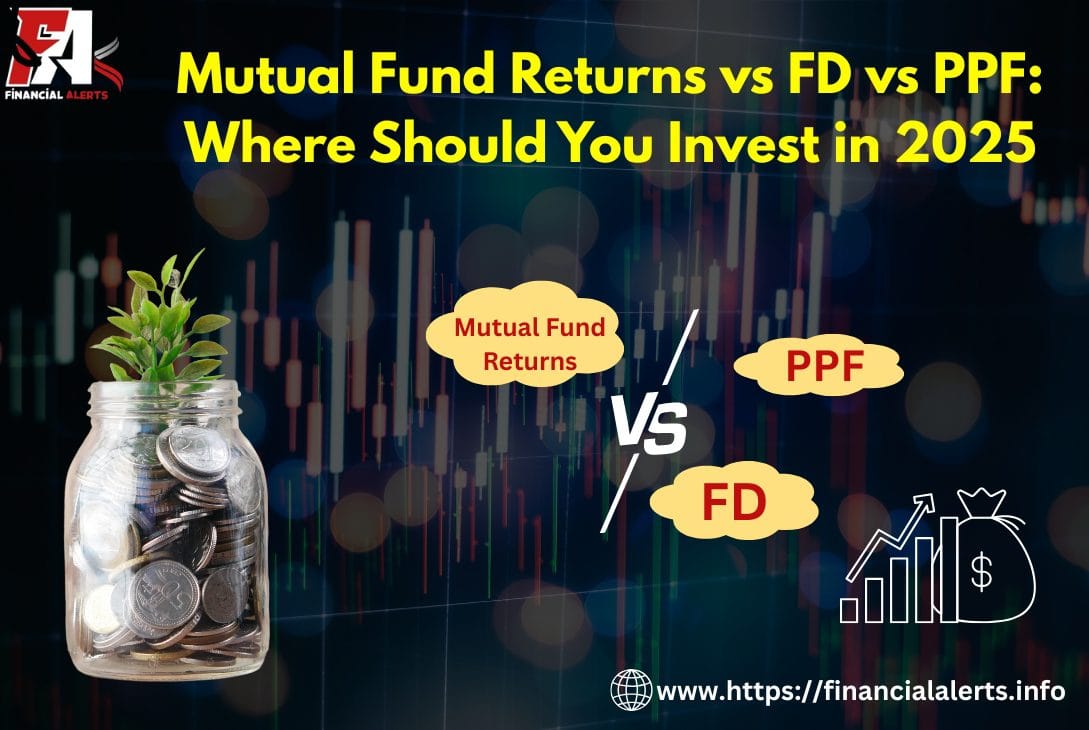By 2025, financial preparation will be a need not a luxury. With increasing prices, headline-grabbing market crashes, and low interest rates, investors are left unsure Where Should You Invest in 2025 to maximize profits and safeguard their future.
Three of the most popular investment options for Indian investors are Mutual Funds, Fixed Deposits (FDs) and the Public Provident Fund (PPF). Each comes with its own advantages or risks and ideal use-cases. In this blog, we break down the pros or cons and latest returns for all three so you can make an informed decision based on your financial goals.
Understanding the Basics
1. Fixed Deposits (FDs)
FDs are time-limited deposits with a fixed rate of interest that are provided by banks and NBFCs. It is the preferred choice for those who are risk sensitive.
2. Fund for Public Providence (PPF)
PPF is a long-term savings plan that has a 15-year lock-in period and is supported by the government. Interest is tax-free, and it provides tax benefits under Section 80C.
3. Mutual Funds
Professional fund managers manage the market-linked instruments known as mutual funds. The kind of fund (like equity, debt, or hybrid) and how the market is doing can change your returns.
FD Interest Rates 2025: What to Expect?
In 2025, FD interest rates 2025 in India are averaging between 6% to 7.5%, depending on the tenure and the bank. Senior citizens usually get 0.5% extra interest. While FDs are safe, their returns may not always beat inflation, which is a crucial consideration.
Pros:
- Guaranteed returns
- Easy to understand
- Safe (especially in scheduled banks)
Cons:
- Returns are taxable
- Cannot beat long-term inflation
- Penal charges on premature withdrawal
PPF interest rate 2025: Stability with Tax-Free Returns
In 2025, the PPF interest rate 2025 stays at 7.1%, as it was the year before. PPF interest rate 2025, despite its lack of shine, is perfect for long-term financial objectives like retirement or the education of children.
Pros:
- Tax-free interest
- 80C tax benefits
- Government-backed and secure
Cons:
- 15-year lock-in
- Low liquidity
- Moderate returns compared to equity instruments
2025 Mutual Fund Returns: Balancing Risk and Return
As of now in 2025, debt funds have provided returns of about 6% to 8% annually, while stocks mutual funds have produced typical returns of 10% to 14%. Mutual funds have traditionally outperformed both FDs and PPF in the long run, however returns are not guaranteed.
Pros:
- Potential for high returns
- Flexibility in tenure and amount
- Diversified investment options
Cons:
- Market-linked and subject to volatility
- Requires understanding of risk
- Returns are taxable based on tenure and type
Mutual Fund vs FD vs PPF: Head-to-Head Comparison
| Feature | Mutual Funds | Fixed Deposits (FD) | Public Provident Fund (PPF) |
| Returns (2025) | 10–14% (equity funds) | 6–7.5% | 7.1% |
| Risk | Medium to High | Low | Very Low |
| Taxation | LTCG/STCG applies | Interest taxable | Tax-free |
| Liquidity | High (open-end funds) | Low to Medium | Very Low (15-year lock-in) |
| Lock-in Period | None (except ELSS) | Varies (minimum 7 days) | 15 years |
| Ideal For | Growth seekers | Conservative savers | Long-term planners |
Which is better FD or mutual fund?
Many people ask, “Which is better FD or mutual fund?” The answer lies in your financial goals and risk appetite.
For cautious investors seeking confident profits and capital protection, FDs are a better option. However, mutual funds can provide superior long-term gain if you want your money to work harder and are prepared to put up with short-term volatility.
For instance:
- Want stability for 1-3 years? FD may work better.
- Planning for retirement or wealth creation over 5+ years? Mutual funds are your friend.
Where Should You Invest in 2025
- First choice (less than three years): Select FDs for security.
- Medium-Term Objectives (3–7 years): Take into account balanced hybrid funds or debt mutual funds.
- Long-Term Goals (7+ years): Combine equity mutual funds and PPF for tax benefits and capital growth.
Real-Life Scenario: A 2025 Investment Strategy
Introducing Radhika, a 35-year-old Mumbai-based working professional. This year, she hopes to invest ₹5 lakhs. She divides her investments as follows:
- ₹2 lakhs in Mutual Funds (SIP in large-cap equity)
- FDs totaling ₹1.5 lakhs (one-year emergency fund fixed deposit)
- ₹1.5 lakhs in PPF (for tax advantages and long-term savings)
By doing this, she balances liquidity or safety and growth, creating a strong foundation for 2025 and beyond.
FAQs – Mutual Fund vs FD vs PPF in 2025
Q1. Which gives better returns in 2025: FD, PPF, or mutual funds?
A: The largest possible returns in 2025 are offered by mutual funds, particularly equities funds (10–14%), PPF (7.1%), and FDs (6–7.5%). But there are risks related to greater returns.
Q2. Will FD interest rates 2025 be enough for greater price increases?
A: In 2025, most FD interest rates 2025 fall short of long-term inflation, particularly after taxes. They work best for temporary security instead of generating money.
Q3. In 2025, is PPF still a good investment?
A: PPF is still a long-term, safe, tax-free investment that’s perfect for retirement or kids’ schooling. However, because of the 15-year lock-in, it isn’t right for short-term objectives.
Q4. Which is better: FD or mutual fund in 2025?
A: For cautious investors who value safety, FDs are preferable. For people who want greater long-term returns and can tolerate some risk, mutual funds are the better option.
Q5. Can I invest in all three: FD, PPF and mutual funds?
A: Absolutely! A diversified investment strategy combining all three offers balanced growth or tax efficiency and financial security.
Conclusion
Each of these investment options—FD, PPF and Mutual Funds—has its own purpose in a smart portfolio. Don’t put all your eggs in one basket. Instead, align your investments with your life goals or risk profile and investment horizon.
In 2025, with market dynamics shifting fast, it’s more important than ever to be proactive or stay informed and invest wisely.

I am a digital marketing executive as well as content writer in the mutual funds related blogs. My goal is to provide simple, interesting and reliable information to readers through my articles so that they always stay updated with the world of mutual funds.



